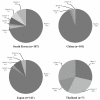Epidemiology of astrovirus infection in children
- PMID: 22474461
- PMCID: PMC3315622
- DOI: 10.3345/kjp.2012.55.3.77
Epidemiology of astrovirus infection in children
Abstract
Human astrovirus (HAstV) is a major cause of acute diarrhea among children, resulting in outbreaks of diarrhea and occasionally hospitalization. Improved surveillance and application of sensitive molecular diagnostics have further defined the impact of HAstV infections in children. These studies have shown that HAstV infections are clinically milder (diarrhea, vomiting, fever) than infections with other enteric agents. Among the 8 serotypes of HAstV identified, serotype 1 is the predominant strain worldwide. In addition to serotype 1, the detection rate of HAstV types 2 to 8 has increased by using newly developed assays. HAstV is less common compared with other major gastroenteritis viruses, including norovirus and rotavirus; however, it is a potentially important viral etiological agent with a significant role in acute gastroenteritis. A better understanding of the molecular epidemiology and characteristics of HAstV strains may be valuable to develop specific prevention strategies.
Keywords: Acute gastroenteritis; Diarrhea; Epidemiology; Human astrovirus; Serotype.
Figures


Similar articles
-
Molecular and epidemiological characterization of human adenovirus and classic human astrovirus in children with acute diarrhea in Shanghai, 2017-2018.BMC Infect Dis. 2021 Jul 29;21(1):713. doi: 10.1186/s12879-021-06403-1. BMC Infect Dis. 2021. PMID: 34325664 Free PMC article.
-
Changing pattern of prevalence and genetic diversity of rotavirus, norovirus, astrovirus, and bocavirus associated with childhood diarrhea in Asian Russia, 2009-2012.Infect Genet Evol. 2019 Jan;67:167-182. doi: 10.1016/j.meegid.2018.11.006. Epub 2018 Nov 9. Infect Genet Evol. 2019. PMID: 30414977
-
Astrovirus infection in hospitalized children: Molecular, clinical and epidemiological features.J Clin Virol. 2017 Sep;94:79-85. doi: 10.1016/j.jcv.2017.07.014. Epub 2017 Jul 25. J Clin Virol. 2017. PMID: 28772169
-
Role of astroviruses in childhood diarrhea.Curr Opin Pediatr. 2000 Jun;12(3):275-9. doi: 10.1097/00008480-200006000-00018. Curr Opin Pediatr. 2000. PMID: 10836166 Review.
-
Acute gastroenteritis outbreaks caused by human astrovirus, 1978-2021: A systematic review.Biosaf Health. 2023 Mar 5;5(2):120-125. doi: 10.1016/j.bsheal.2023.02.004. eCollection 2023 Apr. Biosaf Health. 2023. PMID: 40078833 Free PMC article. Review.
Cited by
-
An overview of viruses discovered over the last decades and drug development for the current pandemic.Eur J Pharmacol. 2021 Jan 5;890:173746. doi: 10.1016/j.ejphar.2020.173746. Epub 2020 Nov 19. Eur J Pharmacol. 2021. PMID: 33221318 Free PMC article. Review.
-
Complete Genome Sequences of Human Astrovirus Prototype Strains (Types 1 to 8).Microbiol Resour Announc. 2019 Feb 14;8(7):e01611-18. doi: 10.1128/MRA.01611-18. eCollection 2019 Feb. Microbiol Resour Announc. 2019. PMID: 30801067 Free PMC article.
-
Unveiling Viruses Associated with Gastroenteritis Using a Metagenomics Approach.Viruses. 2020 Dec 13;12(12):1432. doi: 10.3390/v12121432. Viruses. 2020. PMID: 33322135 Free PMC article.
-
Adaptive immunity restricts replication of novel murine astroviruses.J Virol. 2012 Nov;86(22):12262-70. doi: 10.1128/JVI.02018-12. Epub 2012 Sep 5. J Virol. 2012. PMID: 22951832 Free PMC article.
-
Gastrointestinal organoids in the study of viral infections.Am J Physiol Gastrointest Liver Physiol. 2023 Jan 1;324(1):G51-G59. doi: 10.1152/ajpgi.00152.2022. Epub 2022 Nov 22. Am J Physiol Gastrointest Liver Physiol. 2023. PMID: 36414538 Free PMC article. Review.
References
-
- Glass RI, Noel J, Mitchell D, Herrmann JE, Blacklow NR, Pickering LK, et al. The changing epidemiology of astrovirus-associated gastroenteritis: a review. Arch Virol Suppl. 1996;12:287–300. - PubMed
-
- Matsui SM, Greenberg HB. Astroviruses. In: Knipe DM, Howley PM, editors. Fields virology. 4th ed. Philadelphia: Lippincott Williams & Wilkins; 2001. pp. 875–894.
-
- Dalton RM, Roman ER, Negredo AA, Wilhelmi ID, Glass RI, Sánchez-Fauquier A. Astrovirus acute gastroenteritis among children in Madrid, Spain. Pediatr Infect Dis J. 2002;21:1038–1041. - PubMed
-
- Gray JJ, Wreghitt TG, Cubitt WD, Elliot PR. An outbreak of gastroenteritis in a home for the elderly associated with astrovirus type 1 and human calicivirus. J Med Virol. 1987;23:377–381. - PubMed
LinkOut - more resources
Full Text Sources
Other Literature Sources

